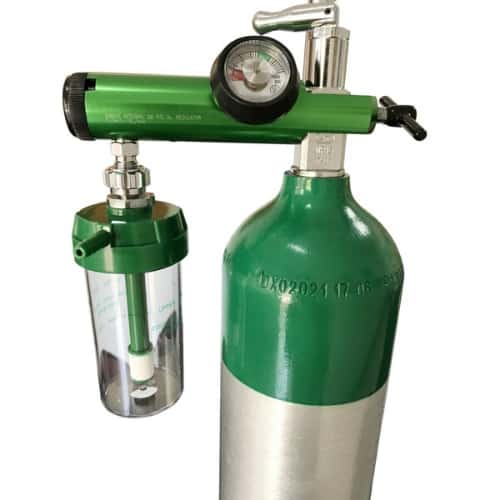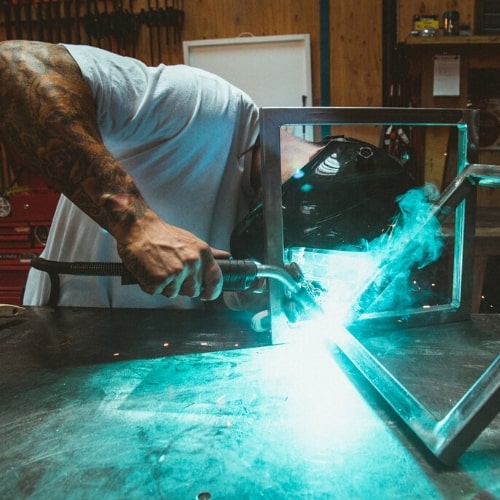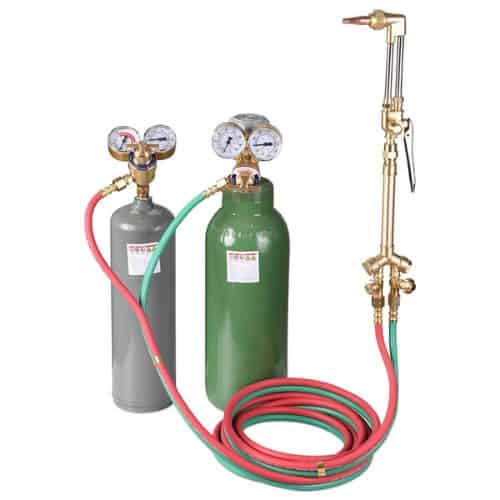There’s a lot of debate around the differences and similarities between welding oxygen and medical oxygen. But there’s a bit of misinformation going around the topic.
Is welding oxygen the same as medical oxygen? Both gases differ by the grade of oxygen. The medical-grade oxygen has 99.5% oxygen with more purity than the welding grade (99.2%). It’s used to assess human breathing and legally you must have a prescription in order to buy medical oxygen.
First, let’s agree on some definitions and clear up misunderstandings.
Table of Contents
Oxygen
For starters, to understand all the other kinds of oxygen and the words you might be hearing flying around, like “industrial oxygen”, “medical oxygen” and of course “welding oxygen”, we should define oxygen itself.
Many people refer to the air around us as oxygen, this is a mistake. The air around has only about 20% of oxygen, the rest are other gases, including Nitrogen and Carbon dioxide.

Oxygen itself, although non-combustible by itself, it can cause and accelerate fires and explosions. This is particularly important as the ambient atmosphere becomes oxygen-enriched.
It means that the gasses mix has more than 23% of oxygen according to the Compressed Gas Association (CGA)
Oxygen-enriched atmospheres must be handled with the same care as pure oxygen. For example, if the percentage of oxygen is 23.5%, it will ignite other gasses 8x faster than normal.
But that’s where the similarities between pure oxygen or compressed oxygen and oxygen-enriched mixtures end.
According to The United States Pharmacopoeia (USP), for oxygen to be labeled, the cylinder must contain at least 99% oxygen.
How oxygen got there and what other gasses or mixes are in the cylinder with it makes up most of the important clarifications for our discussion.
Production of Oxygen
To meet the USP label, the process of oxygen production must be specified. There are generally 2 ways to produce oxygen commercially.
Air-Liquefaction Process
Also called the fractional distillation of air process. In this process, gasses are turned to liquid form by compressing and cooling.
This causes the separation of oxygen from nitrogen and the other gasses as their boiling points differ.
Once they’re separated, oxygen is then further purified and then bottled.
Electrolyte Process
This process uses water for its source of oxygen rather than air. An electric current is used to break down hydrogen and oxygen. Hydrogen is collected at the negative terminal and oxygen at the positive. After that, oxygen is compressed and bottled.
This is important to understand. Some people think that the difference between welding oxygen and medical oxygen has to do with the production stage.
This assumption is false, both could be produced either way. The air-liquefaction process is the one usually used. But it doesn’t make a difference for the end result.
It’s even more irrelevant now because most oxygen sold is labeled by the USP and the compartments aren’t separated like before to “Industrial oxygen” and “Medical oxygen”.
This leads to the question, “If that isn’t the difference, then what?”
Before answering this, first, we should clarify the grading system of oxygen. Once Oxygen is produced, it’s then compressed and packed into different grades.
Oxygen Grades Welding Vs Medical
CGA has identified seven grades of oxygen, A to G, A being 99.0% oxygen, and G 99.55%. The grades are classified according to the purity of the oxygen.
They’re also graded according to how much of the other gasses are still present. In addition to the process used for filling cylinders.
Grade A is the minimum requirement to be labeled by the USP. Usually, the grades are separated according to the industries they’re used for.
These industries include the welding industry and the medical industry. So how do those two grades differ?
Welding Grade
Welding grade was usually slightly less pure than the medical grade. The oxygen percentage made up to 99.2% for welding purposes.
It’s used to produce heat and stabilize the process in welding; joining metals for industrial purposes.

Medical Grade
The medical-grade oxygen used to have 99.5% oxygen which have more purity than the welding grade. It’s used to assess human breathing.
It’s different from Aviation Breathing Oxygen (ABO), which is way more strictly regulated and usually dried further.
As we’ve already mentioned, this isn’t really the case anymore. It turned out to be way more expensive to have different cylinders for different grades.
So now most oxygen suppliers don’t have those different cylinders and are all just USP labeled.
They’ll fill your cylinder, whatever you’ll use it for whether Welding or medical, from the same tank.
So you’re probably asking now, “then why do they have different prices?”
Well, first we did mention that the oxygen tank that both welding and medical oxygen are filled from is the same. The quality and production of that oxygen are the same, yes.
But the filling process is different and also, more importantly, the legal procedure that follows both.
Filling the Cylinders
The source tank is the same, but how they’re both filled differs.
Filling Welding Cylinders
When you take your oxygen cylinder to be refilled, you’ll be asked to specify for what use. If it’s for welding, then the cylinder will be checked for acetylene.

If there’s a presence of acetylene, the cylinder will be cleaned and refilled with oxygen from the tank, If there isn’t, then the cylinder will be refilled right away.
Filling Medical Cylinders
The cylinder will be evacuated right away then filled. The process here is straight forward in terms of mechanics, but a bit more demanding in terms of documentation.
Legality
For medical oxygen, you must have a prescription. All oxygen-related medical objects are also sold with prescriptions.
So the difference here lies with the liability, rather than an actual difference in the oxygen being filled into the cylinder.
Welding Oxygen vs Medical Oxygen FAQs
Let’s close out this page about welding oxygen vs medical oxygen with answers to some of your most frequently-asked questions about them!
Does oxygen expire?
Does oxygen expire? No oxygen does not expire. Medical gasses have unique stability characteristics, and as long as users store them correctly at the correct temperatures and there are no contaminants, oxygen’s shelf life should be unlimited.
The FDA does not include medical gasses such as oxygen on their list of gasses that must bear an expiry date in § 211.137(a.) However, the storage cylinders are more likely to fail; than the contained stable elements.
Can you breathe pure oxygen?
Can you breathe pure oxygen? Breathing pure oxygen over extended periods can lead to oxygen toxicity leading to convulsions and ultimately death. It is not the volume of percentage purity of oxygen that holds the threat but the partial pressure of the oxygen that causes the toxicity.
Partial pressure is calculated by multiplying ambient pressure by concentration. At atmospheric pressure (everyday pressure), this works out to 21kPa. When breathing pure oxygen, partial pressure of 100kPa is gradually toxic.
However, if the atmospheric pressure is lowered to one-fifth of the atmospheric pressure, the partial pressure is 20kPa which is safe to breathe indefinitely. NASA has used this reduced pressure in space vehicles in the past.
How long can you breathe 100% oxygen?
How long can you breathe 100% oxygen? Breathing pure oxygen at atmospheric pressure would eventually cause physiological damage because our bodies have evolved to breathe 21% oxygen. However, these effects would only become life-threatening after only a few days.
However, at pressures greater than 1 atmosphere, pure oxygen will cause seizures with a few hours in instances such as hyperbaric chambers.
Can you breathe welding oxygen?
Can you breathe welding oxygen? No. You should not breathe welding oxygen. Medical oxygen is certified to contain a stable percentage of oxygen below a strict threshold of impurities. Tanks have to be cleaned to exacting standards to ensure that no contaminants may harm the user.
Welding oxygen does not carry this particular ‘human grade’ certification. However, both welding and medical oxygen are created by the same process, including some degree of purification.
If it were an emergency and no medical grade oxygen available, one could use welding oxygen as a life-saving option.
One would need to sterilize the welding regulators and hoses to avoid contamination, and the welding oxygen could only be a short-term solution.
What is the average price of welding oxygen cylinders or Tanks?
What is the average price of welding oxygen cylinders or Tanks? Oxygen is less expensive than acetylene, and one should expect to pay around $20 to refill tanks of approximately 240 cubic feet. Oversize tanks shouldn’t cost you more than $35 to refill.
Below you can find the empty oxygen cylinder prices:
- 20 cu/ft Type “R” Oxygen Welding Cylinder CGA 540 – EMPTY $115.99
- 40 cu/ft Oxygen Welding Cylinder Tank CGA 540 – EMPTY-$180.99
- 80 cu/ft Oxygen Welding Cylinder CGA 540 – EMPTY $230.99
- 125 cu/ft Oxygen Welding CylinderCGA 540 – EMPTY $295.99
What are the different welding oxygen tank sizes?
What are the different welding oxygen tank sizes? Compressed oxygen cylinders are made in several sizes ranging from less than 20 cu/ft (0.56m3) to more than 300 cu ft (8.5 m3). However, the cylinders most frequently used are the 244cu/ft tanks that stand nearly 5 feet tall, including the cap.
These cylinders, when full, contain 244cu/ft of oxygen at a pressure of 2200 psi measures at 20C (700F)
Oxygen cylinders are typically painted green and made of steel, and all have a cylinder valve and a screw-on steel cap that protects the cylinder when not in use (except the small “R” tank)
Do welding oxygen tanks expire?
Do welding oxygen tanks expire? No. welding oxygen tanks do not expire. Although there is no set expiration date for your oxygen cylinder, typically the tanks you should conduct a tank inspection every 5-10 years, depending on the intensity of use.
Tanks may lose their ability to hold oxygen. Look out for signs of wear, leaks, corrosion or rust and ensure your tank is safely closed and stored when not in operation.
You will find the dates of cylinder manufacture on the shoulder of the standard cylinder, and below that, the dates of re-testing.
Typically the numerals will state the month of manufacture followed by double digits showing the year. For example, 4-98 would be March 1998.
What is a welding oxygen regulator?
One of the most critical parts of gas welding is the gas regulator, which controls the flow of gas for welding and cutting.
So, what is a welding oxygen regulator? The regulator takes the pressurized incoming flow and moderates the flow to the appropriate delivery pressure. All regulators have specific inlet connections according to the type of gas that they regulate.
These specifications are known as CGA fittings which are standardized connections developed by the Compressed Gas Association.
Oxygen regulators make use of a 540 CGA connection. The CGA-540 connection consists of clockwise turning threads on a male connection and requires clockwise threads on a female connection.
Can I use an argon regulator for oxygen?
The critical difference between the argon and Oxygen regulators is the delivery gauge. The oxygen regulator shows pressure in psi and bar, while the argon shows gars in Flow Rate or liters per minute and cubic feet per hour.
Can I use an argon regulator for oxygen? No. You should not use argon regulator for oxygen. Although there is not much difference between an Oxygen and Argon regulator, using an argon regulator for an oxygen cylinder may be hazardous.
Oxygen regulators have been put through a rigorous cleaning process to ensure there are no hydrocarbons in them, as that may lead to an explosion.
Where do they get oxygen from?
Where do they get oxygen from? Commercial, pressurized oxygen is extracted from liquid air in large batches. At temperatures of −297°F (−183°C), the air turns into liquid form and is then compressed and passed through an expansion engine with a piston.
As the air expands, the pistons move and decrease the air pressure and temperature. The air rotates through several expansion engines until it is liquid and then transported to holding chambers.
The liquid is then boiled to release the nitrogen because nitrogen boils at a lower point −320’F; 195°C) than oxygen.
The liquid remaining is around 97-100% oxygen and transported in high insulation chambers until dispersed into the specialized oxygen cylinders.
Alternatively, the oxygen is distilled via an electrolyte process whereby water is broken into hydrogen and oxygen via electric current. Each gas is then separated and stored for use in specialized cylinders.
What is the difference between oxygen and compressed air?
What is the difference between oxygen and compressed air? Compressed air has a completely different use and composition to oxygen, and one must never use the two interchangeably in welding practice. Air is a mixture of several gasses such as oxygen (21%), nitrogen (75%) and a combination of other gasses, including helium, neon, hydrogen and carbon dioxide.
All these gasses are dissolvable in our blood.
Oxygen is an element referred to as O2, and it is not flammable on its own; it promotes the combustibility of other substances.
In fact, compressed welding oxygen may spontaneously combust when mixed with oils. Using pressurized oxygen in the place of compressed air to clean a surface or your clothing may result in fire.
Any equipment that uses compressed oxygen should be oil-free and well ventilated.
How many hours does an oxygen tank last?
How many hours does an oxygen tank last? An oxygen tank lasts between 30 minutes and 2 hours depending on the tank capacity. Below you can find the burn time figures for Acetylene and Oxygen:
- 20 cubic feet of gas per tank -30 minutes
- 40 cubic feet of gas per tank- Ihr
- 75 cubic feet of gas per tank-1.5hr
- 145 cubic feet of gas per tank-2hr
Can Oxygen Tanks Explode?
Can Oxygen Tanks Explode? Yes. Oxygen tanks may indeed explode, an example being an incident in the NCBI report on the loss of three lives in an oxygen cylinder explosion. The intensity of the explosion was such that human remains were found in a radius of 25 feet and the cylinder top found 1km away from the scene.
The report cites the leading causes of explosions when using oxygen are:
- leaks in equipment leading to oxygen enrichment
- Use of materials incompatible with oxygen
- Use of oxygen in equipment not designed for oxygen
- User carelessness in the use of oxygen equipment.
Two of the biggest dangers when welding with oxygen are:
- A flashback. A flashback occurs when the flame front does not extinguish but burns backwards beyond the mixing chamber via the hoses into the regulator gas supply.
- Reverse flow. Reverse flow occurs when the oxygen cylinder is depleted simultaneously as the gas tank is not. The fuel gas such as acetylene may flow into the regulator hose and regulator and explode when the gasses are lighted before the oxygen is bled off.
Can you buy your own oxygen tank?
Can you buy your own oxygen tank? Yes. You may purchase your own oxygen tank for welding, and they are also available for lease. One may buy medical oxygen tanks that store specific amounts of compressed oxygen as well.
However, to purchase an oxygen concentrator, you will need a doctor’s prescription stating your oxygen level due to FDA regulations.
What is the working pressure of oxygen and acetylene?
What is the working pressure of oxygen and acetylene? Typically a larger sized cutting tip requires more pressure, but when recommended pressure settings are not indicated, one should not exceed 40 psi for oxygen and 10 psi for acetylene.
However, oxygen has a higher pressure setting than acetylene. The specific pressure depends on the cutting tip and the manufacturer’s recommended settings.
Conclusion
If you were wondering if welding oxygen the same as medical oxygen, we hope you found the answer here.
The bottom line is, most commercial oxygen is the same USP labeled oxygen. The process of getting the oxygen from the tank to your cylinder is what makes up the difference.
Recommended Reading
What Gases Do MIG Welders Use >> Welding Shielding Gas | Complete Guide
How to Use a MIG Welder Without Gas | Is Gasless MIG Welding any Good?
How Many Amps Do I Really Need for a MIG Welder?
Here are some of my favorite tools & equipment´s
Thank you for reading this article. I hope it helps you find the most recent and accurate information for your welding project. Here are some tools that I use daily and hope you´ll also find helpful.
There are affiliate links, so if you do decide to use any of them, I´ll earn a small commission. But in all honesty, these are the exact tools that I use and recommend to everyone, even my own family. (NO CRAP)
To see all my of most up-to-date recommendations, check out this resource that I made for you!


